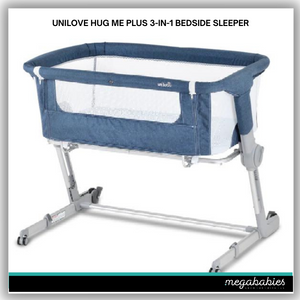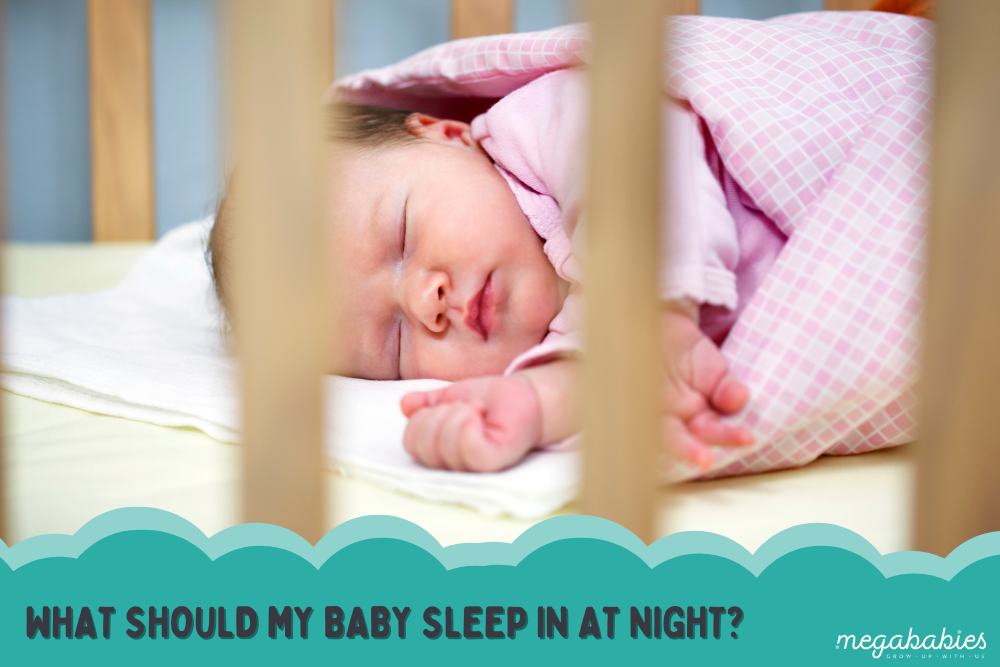There’s something incredibly peaceful and precious in watching a young infant sleep soundly at night. Sleep is so important for babies - it helps with weight gain, mental development and growth, and helps to strengthen the immune system. The fact that newborns can spend around 70% of their day in sleep, just goes to show how crucial it is to find the right sleeping arrangement for your baby. But figuring out baby beds can be tricky, especially when you're trying to balance safety with comfort and convenience. Mega babies has rounded up an overview on the safest places for your baby to snooze based on the latest research.
Infant Sleeping Options
Cribs
Perhaps the most traditional choice for a baby is the crib. A crib is a small, cozy bed that has high sides called slats which keep babies from falling out. Cribs are a safe option for keeping older babies in their beds, and can be used for newborns as well.
Crib Pros:
- Cribs can be used from birth to around two-years old.
- Cribs are made with a sturdy design (little risk of tipping).
- Cribs come in all styles, colors, sizes, and materials.
- Cribs helps new parents establish a sleep schedule with their babies, as there will be no transitioning to a new sleeping place until well after his or her first birthday.
- Cribs can be customized for toddlers with coordinated sheets, blankets and toys; it can feel like a child has their own little space.
- A crib that converts to a bed is a worthwhile long-term investment because your child can use it well beyond the first year.
Crib Cons:
- A crib is bigger than a bassinet. It may not fit into your bedroom and can take up a lot of space in a nursery, which can be an issue if your nursery is particularly small.
- Cribs can be expensive.
- Cribs require a somewhat complicated assembly and disassembly.
Check out our top pick for cribs. The Italian Dadada Chelsea 3-in-1 Convertible Crib gives a clean, modern look to your nursery, adjusts to three mattress positions, and transforms into a toddler daybed.

Bassinets and Moses Baskets
Bassinets and Moses baskets are small cradles that are designed specifically for newborns until the age of 3-6 months old. Bassinets are often used as a temporary sleeping solution before transitioning to a crib.
For how long can a baby sleep in a bassinet?
When a baby hits any one of these three milestones, whichever comes first:
- Baby is able to turn over.
- Baby is able to push up on hands and knees.
- Baby weighs 15 lbs.(or check the weight limit on your particular bassinet).
According to the American Association of Pediatrics, it’s recommended that babies sleep in the same room as their parents for the first 6 months. It is vital to babies’ safety, however, that babies have their own sleep surface and not share a bed with their parents. Bassinets and Moses baskets are a wonderful choice for parents who wish to keep their babies close to them while they sleep without having the headache of assembling a bulky crib in their bedroom.
Bassinet Pros:
- Bassinets offer a cozy sleeping space for a newborn baby (easier to transition from a tight womb to a small sleeping area rather than a large crib). Many parents agree that babies sleep better in tight spaces.
- Bassinets are ideal for bedside use. They can help keep your baby close to you during the night, making nighttime feedings and cuddles easier.
- Bassinets take up less space in the home than cribs, which can be especially helpful if you have a particularly small bedroom, nursery, apartment or home.
- Many bassinets are portable, meaning, some have small wheels, so you can easily move them from room to room, or even take them with you when traveling.
- Bassinets are less expensive than cribs.
Bassinet Cons
- Bassinets can have a small size and high center of gravity which could pose a potential tipping hazard.
- Bassinets can be used for only a few months, making them less economical than a bigger sleeping option, which can be used for longer.
Check out our top pick for bassinets. The DaVinci Archie Portable Bassinet is both stylish and practical. You can stay organized by making use of its lower shelf, which provides storage space to keep diapers, wipes, and other essentials ready to go.

Co-sleepers or Bed side sleeper
Co-sleepers, or adjustable bed side sleepers, are a type of bedside bassinet that attaches directly to an adult bed. They allow an infant to sleep within arm’s reach from parents without the need for a separate crib or bassinet.
Bed side sleeper Pros
- Bed side sleeper can be used from newborn to 6 months.
- Bed side sleepers make for easy nighttime feedings. You can reach over and tend to your baby without having to get up out of bed or fully wake up.
- Bed side sleepers are said to promote bonding between mother and baby as well as increasing the amount of time spent feeding.
- Bed side sleepers are safer than having your baby sleep in your bed.
- Bed side sleepers come in a variety of shapes and sizes.
Bed side sleeper Cons
- Bed side sleepers can make it difficult for an easily-roused baby to stay asleep. For some babies, being too close to mom or dad means waking up from parents’ movements and wakings.
- Bed side sleepers can lead to less sleep for parents, according to some studies.
- Bed side sleepers can present an increased risk for suffocation, being that babies are so close to their parents’ blankets.
Check out our top pick for bed side/co-sleepers. The UniLove Hug Me Plus 3-in-1 Bedside Sleeper can be used as a bed side sleeper, travel crib, or traditional standing crib. With seven adjustment levels and multiple safety features, you can sleep easy knowing that your little one is comfy and safe.

Play Yards and Portable Cribs
Play Yards are an excellent alternative to having a crib in your bedroom because they are easily collapsible and can be moved around the home as needed. Play yards are considered a safe sleep surface and provide soft, breathable siding without crib bumpers. So to answer the questions parents often ask - “Can babies sleep in a pack n play?” Yes, they can! In fact, most hotels offer play yards as their sleeping option for infants and toddlers.
Play yards Pros
- Play yards can be used from birth to around two-years old.
- Play yards can come with removable bassinets.
- Play yards can be used for naps or play.
- Play yards can be a safe-zone for bigger infants. They keep sitting and crawling infants safe, as infants can move freely around in their play yard with their toys with minimal supervision.
- Play yards are portable and lightweight, making them ideal for trips and vacations or for napping kids in different rooms during daytime hours.
Play yards Cons
- Play yards take up a lot of space, making them less ideal for small rooms, apartments, or homes.
- Play yards that are turned to safe-zones can potentially be over-used by parents. Some say that parents can come to use play yards like baby jails, where the natural movements of their baby gets restricted if the baby is left there by the parent for too many hours.
Check out our top pick for play yards. The 4moms Breeze Plus Playard offers a quick, one push open, one pull close. It can be easily moved around the house or packed up for travel. It even comes with a removable bassinet and a baby changing station.

Common Questions Asked by New Parents
What are some baby sleep safety tips?
Nikki Smith, MEd, a certified pediatric and adult sleep consultant explains, “The big thing is that we want to try to help protect our little babies from dangers like choking, suffocation, and SIDS.” According to the American Academy of Pediatrics, your baby should sleep:
- In a standard-size crib, bassinet, portable crib, or play yard that meets the standards of the Consumer Product Safety Commission (CPSC).
- Only on their back, not on their stomach or side.
- Only on a firm sleep surface, like a firm crib mattress covered with a well-fitted sheet.
- Without any soft objects (pillows or stuffed animals) or loose bedding (sheets and blankets).
Can a baby sleep in a swing or bouncer?
Bouncers, swings, and even car seats are a great way to lull a fussy baby to sleep, but they’re not recommended for long stretches of sleep. When developing your baby's sleep patterns or bedtime routines, you should avoid these types of sleepers. It’s best to transfer a sleeping baby from a bouncer, swing, or car seat to their crib, where they can sleep safely on their back.
When can babies sleep in their own room?
The official recommendation from the American Academy of Pediatrics is for parents to share a room with their baby in a separate sleep space (not in their bed) for a minimum of six months and up to one year in order to reduce the risk of SIDS. However, despite the benefits, there is a slight catch-22 when it comes to room-sharing. Studies have shown that babies sleep in a lighter stage of sleep with more frequent arousals when they are in close proximity to a parent, especially a breastfeeding mother. So while room-sharing does help decrease the risk of SIDS, it also means everyone may be getting less restorative sleep.
If you snooze, you lose. Now is the time to order your baby’s bed!
When it comes to deciding what kind of sleeping arrangement is best for your baby, there is no one-size-fits-all answer. Ultimately, the decision should be based on what you feel is best for your baby and your family, having taken all research into consideration. Now that you may have a better idea of what sleeping option you need, Mega babies invites you to browse their crib and nursery furniture to find the perfect sleep solution for your baby.




